In an industry replete with buzzwords and technology advancements, AV-over-IP (AVoIP) continues to dominate conversations and grow more prevalent as an AV signal-transport solution. And although, yes, the reasons have to do with efficiency, cost effectiveness and ease of scalability, there’s actually much more behind AVoIP’s ongoing rise. Here, in Commercial Integrator’s AV-over-IP Deep Dive report, we examine the state of the market, what’s powering AVoIP’s popularity, its most compelling benefits, lingering areas of concern, and whether all the various approaches and protocols are a help or a hindrance to integration professionals today.
CI presents fresh data from our exclusive research study. Moreover, we share perspectives from several technology thought leaders: Sean Wargo, vice president of market insights, AVIXA; Marty Fornelli, CTS-D, CTS-I, senior design engineer, Diversified; John Richards, CTS, VP of engineering, AVI-SPL; Dalton Parker, director of sales and marketing, TVS Pro; and Lincoln King-Cliby, commercial market director, ControlWorks Consulting, LLC.
AVoIP’s Market Penetration
Our CI research study uncovers an interesting fact: Among integrators in our industry, there is wide variance in terms of their AVoIP utilization. A quarter of our respondents say that 25% or fewer of last year’s projects involved AVoIP, while another three in 10 survey takers say more than three-quarters of last year’s installations leveraged AVoIP. That means that, while AVoIP is undoubtedly in ascendance, not all integrators are participating equally. One reason for this, ControlWorks Consulting’s King-Cliby states, may be integrator inertia. “Integrators have been installing matrixes for decades,” he observes. “It’s known and comfortable.” King-Cliby continues, “To truly harness the value of AVoIP, it’s important to aggressively move into that sphere and realize that AVoIP is virtually AVoIT, there’s a critical partnership with the client’s IT department, and the AV/IT convergence needs to be embraced.”
Drawing on Industry Outlook & Trends Analysis (IOTA) data, AVIXA’s Wargo comments, “We roughly estimate that about 50% of revenues are associated with AV-over-IP-based hardware. This would suggest that approximately 50% of deployments are also based upon AVoIP connections.” He predicts slow, steady, healthy continued growth in the coming years, adding, “From here, this will grow faster than the industry is overall, which is targeted to be 5% to 6% CAGR from 2023 to 2028….”
 Other experts seem to predict an even more aggressive move to AVoIP market dominance, with Diversified’s Fornelli declaring that it’s now the rule, rather than the exception. “Even the smallest of systems with a routing matrix of only a few sources and destinations often are better served by AVoIP,” he states. AVI-SPL’s Richards agrees, saying that, although point-to-point applications can deliver economical, reliable solutions, he believes that AVoIP “…has [already] become the primary signal transport in systems needing more than point-to-point extension.”
Other experts seem to predict an even more aggressive move to AVoIP market dominance, with Diversified’s Fornelli declaring that it’s now the rule, rather than the exception. “Even the smallest of systems with a routing matrix of only a few sources and destinations often are better served by AVoIP,” he states. AVI-SPL’s Richards agrees, saying that, although point-to-point applications can deliver economical, reliable solutions, he believes that AVoIP “…has [already] become the primary signal transport in systems needing more than point-to-point extension.”
TVS Pro’s Parker observes that ever more integrators are realizing that AVoIP provides a great base for flexible, reliable systems that can be easily expanded upon, without having to completely rebuild. And our industry is still only scratching the surface of the potential, he says, adding, “AVoIP solutions are aggressively gaining market share as more products are introduced and interoperability increases” across manufacturers and signal types.
Who is Powering AVoIP’s Ascent?
Everyone seems to agree that AVoIP is already commanding a significant market share, and its growth isn’t slowing. The question then becomes this: Who is powering the ongoing ascent? Fornelli thinks the integration community is perhaps the prime mover. “I feel that we, as design/integration partners, are often pushing the trend forward due to the vast improvements made recently to the ease in deployment of video networks,” he observes, particularly crediting NETGEAR for making the transition accessible to everyone. Parker notes that, of course, designers and integrators can only provide solutions with the best tools they have available — a factor that puts hardware manufacturers in the driver’s seat. And Richards sees vendors across the industry pushing the pedal to the metal. He says, “I believe that there is more selection in the AV-over-IP product category, while the traditional matrix switchers are maintained or updated to the latest chipsets as needed.”
But if you ask Wargo, it’s likely that vendors are simply seeking to satiate the market’s strong appetite for AVoIP. “Yes, some manufacturers have led the charge,” he observes, “but the demand side was a key component in getting us here….” He points to a fact that all of us can attest to: IT departments are increasingly involved in the management of AV systems. “This means they are naturally inclined to think about how technology can be supported on existing networks,” Wargo says, “rather than analog low-voltage connections.”
That being said, King-Cliby reminds us that a lot of clients still haven’t realized there’s a better way than the AV approaches they’ve always taken. He praises vendors and alliances for “…doing a good job of helping with the education and awareness,” and he praises consultants’ one-on-one client-education efforts.
Forecast for AVoIP Ubiquity
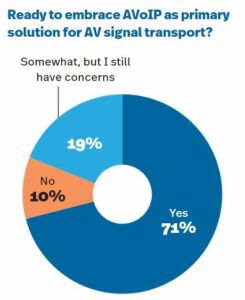 AVoIP ubiquity might still be a transition in progress, but all signs point to the eventuality that AVoIP will become the primary AV signal-transport solution for integrators’ installations. Indeed, more than seven in 10 of our survey takers declare that they’ve either already embraced AVoIP as primary or have now readied themselves to. What’s more, nearly half of our respondents report that they expect 76% to 100% of their 2024 projects to involve implementing AVoIP. King-Cliby thinks of these developments in a historical context. “Twenty years ago, VoIP for corporate phones was a daunting enigma compared to traditional analog or TDM-based telephony for corporate PBXes,” he reflects. Of course, that quickly changed. Likewise, King-Cliby continues, “I think AVoIP is now well on its way to becoming the primary AV transport.”
AVoIP ubiquity might still be a transition in progress, but all signs point to the eventuality that AVoIP will become the primary AV signal-transport solution for integrators’ installations. Indeed, more than seven in 10 of our survey takers declare that they’ve either already embraced AVoIP as primary or have now readied themselves to. What’s more, nearly half of our respondents report that they expect 76% to 100% of their 2024 projects to involve implementing AVoIP. King-Cliby thinks of these developments in a historical context. “Twenty years ago, VoIP for corporate phones was a daunting enigma compared to traditional analog or TDM-based telephony for corporate PBXes,” he reflects. Of course, that quickly changed. Likewise, King-Cliby continues, “I think AVoIP is now well on its way to becoming the primary AV transport.”
Wargo agrees that the stage is set for AVoIP to capture primacy, pointing to everything “…from the demand side all the way through to the protocols and products.” He continues, “The last ingredient is for the channel itself — the integrators and installers — to further expand their skills and competencies in this area.” AVIXA created the AV Networking Professional (ANP) certification as a tool to help AV and IT professionals prove their AV networking skills as these two fields converge. This kind of certification training helps support integrators in their ongoing evolution.
Fornelli, perhaps more than any of our other interviewees, believes that AVoIP’s time isn’t sometime in the future but, rather, is now. If he’s right, integrators who are still establishing their footing working with IT infrastructure should feel a sense of urgency to level-up their knowledge. Some AVoIP alternatives, Fornelli opines, are now “…used only when the appropriate architectural form factors are not available with AVoIP encoders/decoders.” He continues, “However, with more and more available options for AVoIP encoders/decoders that fit within a standard electrical box, those days seem to be numbered, too.”
Considering Vertical Markets and Applications
AVoIP is on track for dominance in the coming years, one reason is its suitability to a broad range of verticals and use cases. “I don’t think there are limits to where you effectively find and use AV-over-IP today,” Richards states. “There is a wide range of performance levels, and that can often drive the needs of the overall system.” Elaborating further, he adds that there “…are many options that support various levels of power and bandwidth,” something that allows infrastructure flexibility and helps mold AVoIP systems to individual vertical-market needs.
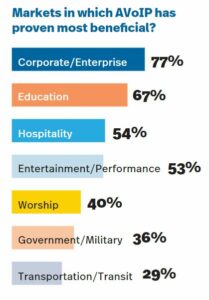 Fornelli shares Richards’ point of view, stating, “I think the current AVoIP landscape is broad enough to cover the specific needs of all verticals at this point.” King-Cliby drives the point home, saying that there are compelling use cases across the board. “I’m having trouble thinking of a vertical where it doesn’t — with the proper education and infrastructure — make a boat load of sense,” he declares. “Even in our residential practice — typically, very large properties — which I’m personally more removed from, AVoIP makes a lot more sense to me.”
Fornelli shares Richards’ point of view, stating, “I think the current AVoIP landscape is broad enough to cover the specific needs of all verticals at this point.” King-Cliby drives the point home, saying that there are compelling use cases across the board. “I’m having trouble thinking of a vertical where it doesn’t — with the proper education and infrastructure — make a boat load of sense,” he declares. “Even in our residential practice — typically, very large properties — which I’m personally more removed from, AVoIP makes a lot more sense to me.”
AVoIP does have a case to make everywhere, but the case is particularly compelling in certain verticals — namely, corporate/enterprise and education — for reasons of existing network infrastructure and deployment efficiency. As Wargo observes, “Within an office environment, IP networks already serve the various work and collaboration spaces.” Workers, of course, must access content of all types, including audio and video content, even as they move throughout the environment. “This means AV systems are most easily deployed by leveraging the existing network to ensure an evenness of connection and experience throughout the spaces,” Wargo concludes. The same, of course, applies to education, where students and faculty must leverage technology ecosystems even as they move across campus.
For Parker, the salient question isn’t so much about verticals as it is about system size, scale and scope. “Systems with just a few endpoints are still best served with a fixed-architecture solution,” he opines. Conversely, any deployment that entails sharing individual room resources provides what he calls “a perfect opportunity for AVoIP.” Parker adds, “With the current cost of AVoIP, there is incredible value the larger in scale your project becomes.”
Related: AVoIP Systems on the Technology Fast Track
Benefits of AVoIP
That point helps us transition into a discussion of AVoIP’s notable benefits. Richards cites standardized category cabling and network-switch infrastructure as the most compelling reasons to embrace AVoIP. “The standards used for a wealth of items that range from a PC to specialized audio/video hardware simplifies the connectivity for audio, video, control, power and data, as needed, [in] various equipment locations,” he says. Continuing on the topic of connectivity and cabling, Fornelli remarks that AVoIP systems often place far less of a burden on facilities’ cabling infrastructure. “It is much more economical from a cost standpoint, and easier from a termination/certification standpoint, to use cabling that only needs to support 1Gbps speeds,” he states.
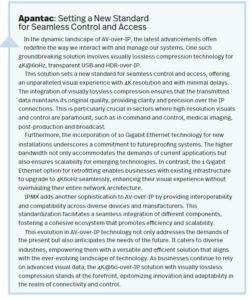 Wargo picks up this theme, saying that, ultimately, the shift to AVoIP comes down to greater efficiency and improved cost effectiveness. “IP connections have to be reliable and cost effective in order to pass the muster of a procurement effort,” he reflects. “That effort is often led by IT departments, who approach technology from a different lens.” King-Cliby adds, “When AV is on the same converged network hardware as the organization, you reduce duplication and operating costs and make things infinitely easier to monitor.” What’s more, converged infrastructure opens up the opportunity to resolve problems before they affect facility operations. King-Cliby adds that it’s “a huge win” for technology partners and clients alike to move away from standalone AV drops and data drops — which might not meet user needs — and avoid the extra operating costs of duplicate networks.
Wargo picks up this theme, saying that, ultimately, the shift to AVoIP comes down to greater efficiency and improved cost effectiveness. “IP connections have to be reliable and cost effective in order to pass the muster of a procurement effort,” he reflects. “That effort is often led by IT departments, who approach technology from a different lens.” King-Cliby adds, “When AV is on the same converged network hardware as the organization, you reduce duplication and operating costs and make things infinitely easier to monitor.” What’s more, converged infrastructure opens up the opportunity to resolve problems before they affect facility operations. King-Cliby adds that it’s “a huge win” for technology partners and clients alike to move away from standalone AV drops and data drops — which might not meet user needs — and avoid the extra operating costs of duplicate networks.
For Parker, one of the most notable benefits centers on AVoIP’s standards-based approach, which not only makes it easier to deliver system add-ons but also tethers integrators’ systems to reputable platforms that will continue to evolve and develop. “With standards such as Dante, NDI, SDVoE and many others, we are able to provide the best brands’ hardware that meets client needs and have the confidence that adding system features in the future is possible,” he states. “It is stupidly easy with all of the AVoIP platforms to grow as needed,” King-Cliby quips.
Parker also mentions that, if AVoIP systems are designed and deployed correctly, it can be impossible to detect any difference in visual performance. “And distance is a non-issue with these protocols, as well,” he enthuses. “Not only can we extend over copper or fiber within a building or campus, but many of these signals can extend across the WAN to reach various cities, states or countries that need to be seamlessly integrated together.”
Current Concerns Regarding AVoIP
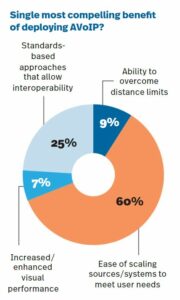 Although AVoIP is finding its way into ever more commercial applications, that’s not to say there are no lingering concerns. If you ask Richards, the biggest concerns with hardware on a network revolve around network security. “Always secure network-connected devices to prevent unauthorized access to systems,” he implores. According to Parker, one way that integrators can prioritize cybersecurity is to configure an AVoIP network to meet clients’ security measures, including by virtually or physically segregating the network. Another option, he says, is to “…select manufacturers that do not use open-source signal methods that can be easily accessed and/or intercepted.”
Although AVoIP is finding its way into ever more commercial applications, that’s not to say there are no lingering concerns. If you ask Richards, the biggest concerns with hardware on a network revolve around network security. “Always secure network-connected devices to prevent unauthorized access to systems,” he implores. According to Parker, one way that integrators can prioritize cybersecurity is to configure an AVoIP network to meet clients’ security measures, including by virtually or physically segregating the network. Another option, he says, is to “…select manufacturers that do not use open-source signal methods that can be easily accessed and/or intercepted.”
King-Cliby, who declares that some of his most rewarding conversations have involved playing “translator” between AV and IT, identifies an ongoing need for network knowledge/education. “Even a lot of really good network administrators I know and have worked with have never really had to deal with multicast and the nuances before their first AVoIP project,” he acknowledges. Integrators likewise must broaden their talent portfolio, Fornelli implies, saying that the skill sets and tools to troubleshoot issues in large systems have shifted away from the traditional methods of testing video and audio signals in baseband systems. “Although these methods are largely still useful, issues often arise that are best diagnosed and resolved by a skilled network professional,” he says. “And, oftentimes, this person is not the same person who is good with a waveform monitor.”
Wargo agrees that skillset and competency are significant limiting factors right now, but he says with optimism that education content is rapidly catching up (e.g., the ANP certification) and notes that many AV professionals mindfully broadened their skills during pandemic-era project lulls.
AVoIP Approaches, Standards and Protocols
Some industry professionals express concern about the large number of AVoIP standards and protocols currently being utilized (e.g., AES67, Dante AV, IPMX, SDVoE, SMPTE ST 2110). Some, perhaps, feel as though this variety of approaches runs counter to the message of standardization. However, diversity of this sort can also be a strength. As Wargo notes, “Having more choices here allows for the best tool to be deployed for the given task. Each standard will offer slightly different benefits — from lower signal loss across a distance to overall higher fidelity.”
Richards emphasizes that many protocol options exist today, and he argues that understanding them is critical to proper hardware/platform selection for clients and projects. As he says, dealing with “…the fragmentation of standards [relies] on learning and understanding the differences between the solutions you select to deploy and support.” Richards underscores the criticality of talking about each system and not assuming they’re similar or support the same features. Further nodding to the increased complexity of today’s networks, he adds, “It’s not uncommon today to have many protocols [living] together on the network.” This makes proper design considerations paramount.
King-Cliby tips his hat to SDVoE, which, he says, is not only highly interoperable but also highly reliable in its interoperability; moreover, he adds, it helps technology professionals avoid vendor lock-in and delivers a solid feature set. On the flip side, he says, “I am a bit surprised ST 2110 hasn’t seen more traction in the commercial space.” Ultimately, King-Cliby expresses optimism on the range of approaches and protocols currently in the market, saying they allow designers and clients to balance performance and other factors. However, he does sound a note of caution. “There is a risk, particularly for some of the lower-performing options, to disappear,” he says, “making long-term support a potential concern.”
Whatever approach to AVoIP an integrator and client might take, Parker offers a valuable reminder: A skilled IT engineer is indispensable to optimize the network for peak performance. That is particularly true when lots of devices are combined on the same physical infrastructure, mixing various transport protocols, each of which might have unique network requirements. “The stability of the system might be at risk if not deployed correctly,” Parker warns.
Meanwhile, Fornelli articulates a vision for a future in which vendor-specific standards are not the norm. More specifically, he points to a future in which ever more products have transitioned to a unified standard in ST 2110 and IPMX. “This standard really makes the most sense for our customers who have a mixture of broadcast/production and meeting spaces in their facilities, and I am honestly disappointed that more vendors have yet to get on board with IPMX,” Fornelli says candidly.
Considering the RMR Angle
As Wargo observes, the conversion of signal to digital via an AVoIP transport enables the creation of more data about utilization, reliability and system state from end to end. This data can then lend itself to managed services, with the purpose of better serving and supporting client deployments. According to CI’s exclusive research study, fewer than four in 10 respondents have successfully leveraged their AVoIP deployments to introduce new managed services and RMR opportunities. This statistic arguably bespeaks a missed opportunity to lean into everything from remote diagnostics and troubleshooting, to upgrade pathing and replacement cycling, to content as a service. “All of this likely only [hints at] what is ultimately possible,” Wargo adds, underscoring the untapped potential.
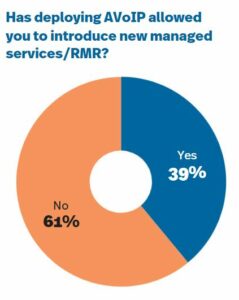 Fornelli expands on this view, saying that AVoIP devices living on networks means “…there is certainly more opportunity for managed services that monitor system health and performance through monitoring and telemetry.” Richards agrees, saying the nature of AVoIP systems — with every input and output residing on a network — expands the possibilities for management and monitoring. “As complexity and system scale go higher, the need for management of the system becomes [greater],” he adds.
Fornelli expands on this view, saying that AVoIP devices living on networks means “…there is certainly more opportunity for managed services that monitor system health and performance through monitoring and telemetry.” Richards agrees, saying the nature of AVoIP systems — with every input and output residing on a network — expands the possibilities for management and monitoring. “As complexity and system scale go higher, the need for management of the system becomes [greater],” he adds.
This vision of leaning into services and long-term outcome assurance aligns with the zeitgeist of the moment in our industry — namely, for integrators to become long-term consultative partners to their clients. “In order to ensure our clients have the best experience possible,” Parker says, “we, as integrators, need to provide augmented services to support these system deployments.” In fact, if you ask Parker why he thinks it will be several years before fixed-architecture hardware is bypassed, one reason he’ll give you is post-installation support for end users’ AVoIP solutions not being where it needs to be. If integrators remedy that, there’ll be a huge opportunity for additional revenues. But, Parker adds, even more importantly for a trusted partner, support services will “…provide the insurance clients are in need of so that their systems will remain as they were intended.”
Biggest Difference-Makers
CI’s research study indicates that a wide range of potential actions and resources could empower the integrator community to leverage AVoIP more effectively. More than six in 10 urge greater consolidation among standards and approaches; more than four in 10 want more information from industry associations; an equal number of survey takers want standards providers to offer additional information. Our survey also captures considerable demand for AVoIP education for integrators’ staff members. In light of those findings, it’s only natural, then, for Wargo to again cite AVIXA’s ANP certification. “Knowledge is power,” he declares. “The more the market is well informed about the technology and various solution approaches, the more we, as a market, will leverage the benefits of AVoIP.”
 We asked each of our respondents to pinpoint the single biggest change our industry could make that would empower integrators and end users alike to better realize the benefits of AVoIP. Fornelli called for more focus on interoperability in the future. “Not only with open standards like IPMX,” he clarifies, “but with openness with control APIs that would enable more AVoIP hardware to be control platform agnostic.” Richards, for his part, disclaims the idea that there is “…a silver bullet that will single handedly change competing desires of flexibility.” He adds, “The rich feature sets bring complexity that is at the core of what this technology category provides.”
We asked each of our respondents to pinpoint the single biggest change our industry could make that would empower integrators and end users alike to better realize the benefits of AVoIP. Fornelli called for more focus on interoperability in the future. “Not only with open standards like IPMX,” he clarifies, “but with openness with control APIs that would enable more AVoIP hardware to be control platform agnostic.” Richards, for his part, disclaims the idea that there is “…a silver bullet that will single handedly change competing desires of flexibility.” He adds, “The rich feature sets bring complexity that is at the core of what this technology category provides.”
Meanwhile, Parker’s answer about AVoIP could really be applied to our industry as a whole — namely, that we must generate excitement within and about our industry to attract the next generation of professionals. “We can teach and train skills,” he acknowledges, “but we need individuals excited and willing to learn an industry that isn’t taught in schools and universities.” That’s particularly true as the AV industry of old reinvents itself to embrace network-centric deployments.
And that leads to the top recommendation from King-Cliby: “For AV to stop being afraid to talk to IT; for IT to stop being afraid to talk to AV; and for both to use more of a common language.”
In Conclusion
One might say that AVoIP is to AV signal transport as direct-view LED is to video display: In both cases, deployments have rapidly gained prevalence, but their growth potential remains unbounded. “For projects that we design or advise on, we’re pretty much all in on AVoIP,” King-Cliby declares. “For the most part, with most clients, AVoIP makes the most sense for flexibility and capabilities relative to more traditional matrix platforms. It is definitely more acceptable today than two or three years ago.” But AVoIP cannot reach its full potential unless lingering issues are reckoned with. That means overcoming integrator inertia, upskilling workforces, remedying potential cybersecurity vulnerabilities and embracing 24/7/365 outcome assurance, which not only pleases clients but also delivers robust revenue.
Assuming those prerequisites are met, the integrator community is in prime position to push AVoIP forward. “We have to educate our clients and end users on new and emerging solutions, provide training on new solutions and provide the best support we can,” Parker exhorts. If our industry can do that, while vendors continue to enhance their network-ready offerings, there’s no limit to how far the AVoIP revolution can go.
Commercial Integrator’s 2024 AV-over-IP deep dive report is proudly supported by Alfatron, Apantac, Audinate, AtlasIED, AV Access, BZBGEAR, Just Add Power, Matrox, MuxLab, RGB Spectrum and Wyrestorm.






